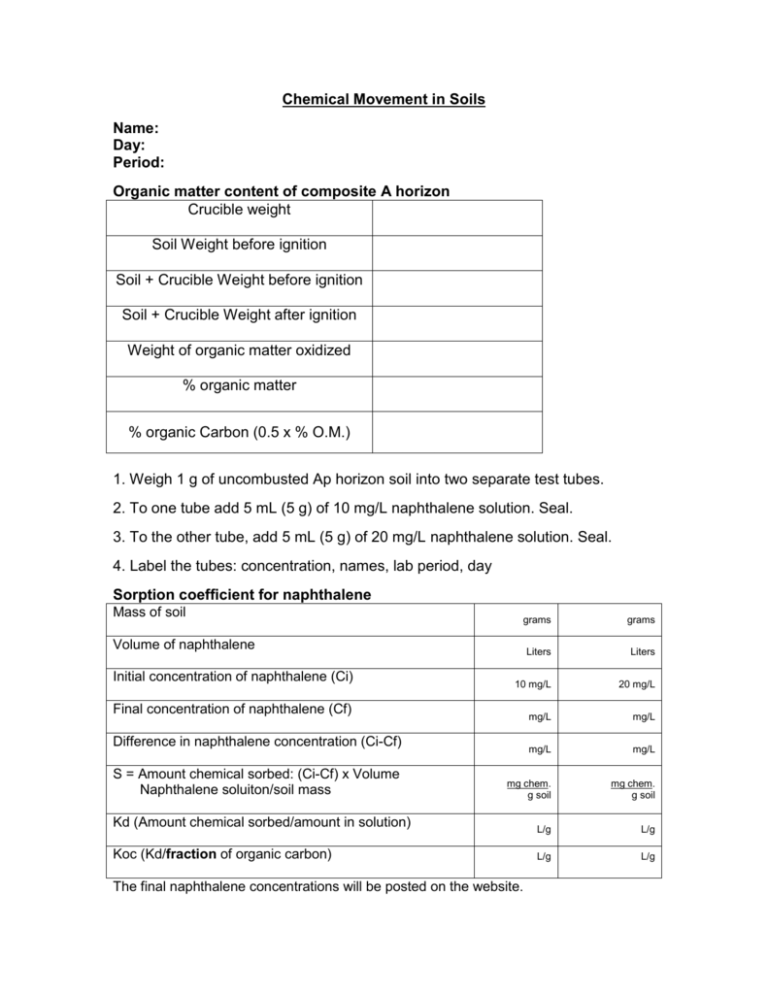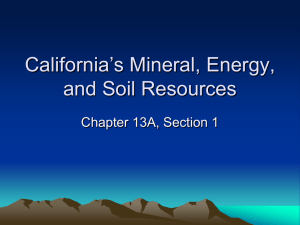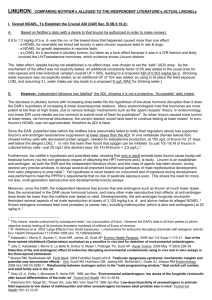Chemical Movement in Soils
advertisement

Chemical Movement in Soils Name: Day: Period: Organic matter content of composite A horizon Crucible weight Soil Weight before ignition Soil + Crucible Weight before ignition Soil + Crucible Weight after ignition Weight of organic matter oxidized % organic matter % organic Carbon (0.5 x % O.M.) 1. Weigh 1 g of uncombusted Ap horizon soil into two separate test tubes. 2. To one tube add 5 mL (5 g) of 10 mg/L naphthalene solution. Seal. 3. To the other tube, add 5 mL (5 g) of 20 mg/L naphthalene solution. Seal. 4. Label the tubes: concentration, names, lab period, day Sorption coefficient for naphthalene Mass of soil grams grams Liters Liters 10 mg/L 20 mg/L mg/L mg/L mg/L mg/L mg chem. g soil mg chem. g soil L/g L/g L/g L/g Volume of naphthalene Initial concentration of naphthalene (Ci) Final concentration of naphthalene (Cf) Difference in naphthalene concentration (Ci-Cf) S = Amount chemical sorbed: (Ci-Cf) x Volume Naphthalene soluiton/soil mass Kd (Amount chemical sorbed/amount in solution) Koc (Kd/fraction of organic carbon) The final naphthalene concentrations will be posted on the website. Lab Report: Turn in the above table and your responses to the CMIS questions. Naphthalene Sorption Isotherm Plot S (mg chem./g soil) vs. Cf (mg chem./ L solution) for 3 data points: the two concentrations determined above, and a zero naphthalene concentration that will be posted with the other results on the website. Determine a best-fit line through the data and based on its slope, determine the overall Kd for the chemical. From the Kd value, calculate a Koc value based on the organic carbon content of the soil. Exercise: CMIS Chemical Movement in Soils Exercise 1 Simulate the movement of Dicamba on both soils. Then simulate the movement of Atrazine on both soils. Start the simulation on January 1. Ensure that the profile depth is 100 cm. Complete the table below. Soil Bulk Density Field Capacity O. C. content Porosity Clay Myakka F.S. Chemical Koc t1/2 Dicamba Atrazine For Dicamba on both soils, pause the simulation on 1/20, 2/4 and 2/17. What is the approximate depth of penetration of the solute front as evidenced by concentrations greater than background. Date Solute Depth Myakka Solute Depth Clay 1/20 2/4 2/17 To what do you attribute the differences in downward movement of Dicamba for the two soils? In an agricultural situation, what could be done to limit the downward movement of Dicamba? For Atrazine, was there a significant difference in movement in the two soils. Why? Was there a difference in the behavior of Dicamba and Atrazine on the two soils? Why? How long did it take for Atrazine to reach the 50 cm depth compared to Dicamba. Why? Exercise 2 Simulate the movement of Linuron on the two soils. Simulate the movement of Maneb on the two soils. Soil Bulk Density Field Capacity O. C. content Porosity Blanton Silt Loam Chemical Koc t1/2 Linuron Maneb Were there differences in movement of Linuron in the two soils? What caused the difference? Were there differences in movement of Maneb in the two soils? Why? Did the two chemicals behave the same on either soil? Why or why not? How long did it take for Linuron to reach the 50 cm root zone for the two soils? For Maneb? Are either of these chemicals likely to pose a significant leaching hazard? Why? Discuss the relative importance of the chemical and soil properties in the movement of the two compounds in the two soils. Exercise 3 Simulate the movement of both chemicals on one of the soils. Run the same chemicals on the other soil. Soil Bulk Density Field Capacity O. C. content Porosity Blanton Silt Loam Chemical Koc t1/2 Linuron Chlorthalonil Which chemical showed the greatest downward movement in the Blanton soil on March 1? Why? Suggest at least one reason why on April 1 a zone of high concentration (red) persisted for Linuron in the Blanton soil, but not for Chlorthalonil despite greater spreading of the chemical. When movement of the two chemicals is simulated on the silt loam, are the chemicals moving with the water applied to the profile? How did the results differ for the silt loam compared to the Blanton soil for both chemicals? On April 11, why was there no region of high concentration for chlorthalonil, but not for linuron on the silt loam? Exercise 4 Choose one combination of the soils and chemicals listed which would facilitate the greatest movement through a soil profile, and another combination to demonstrate the slowest movement. What criteria did you use for both the soils and the chemicals. Run the simulation and describe the results in terms of depth of solute movement at important times, the time it took for the solute to reach the 100 cm depth, persistence of high concentrations of the chemical, etc.








